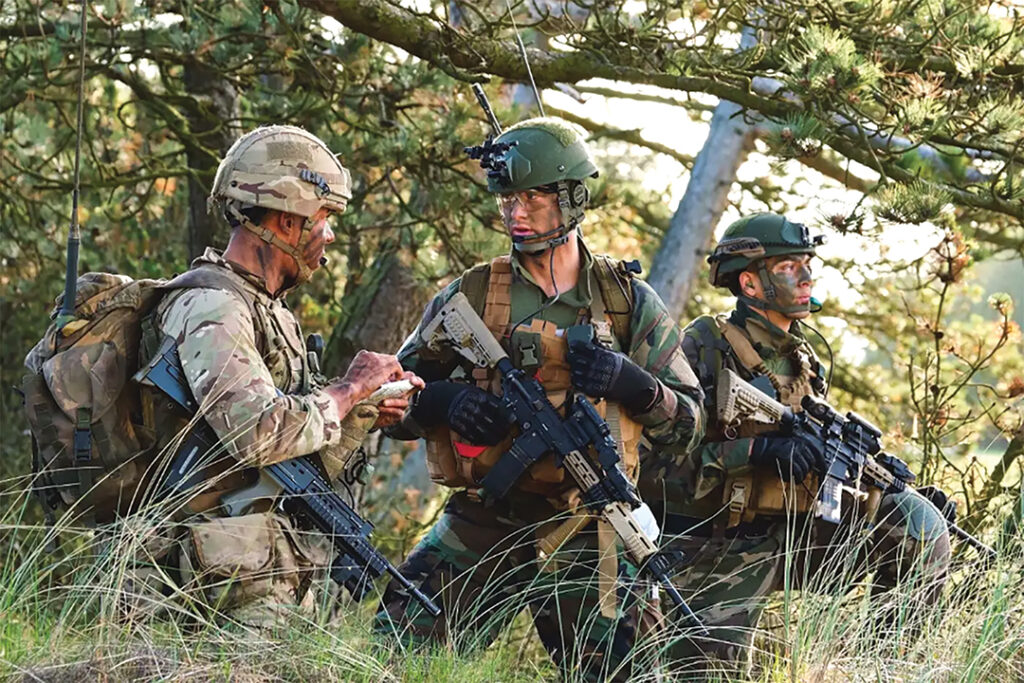UNITED KINGDOM MINISTRY OF DEFENCE
In search of established, proven practices for integrated deterrence, this article highlights the role of the Joint Expeditionary Force (JEF). This powerful military framework focuses on the High North, North Atlantic and Baltic Sea regions, and has several characteristics making it an effective option to senior decision-makers and a key element in participant nation defense.
In June 2022, U.K. Chief of Defence Staff Adm. Sir Tony Radakin described the JEF as a reflection of how the U.K. and like-minded participant nations with shared operational experience and interests had pooled their high-readiness forces for global contingencies. He emphasized it was designed so political decision-makers could respond quickly to crises in core areas of interest but that it was not a standing force. He underlined particularly the JEF’s utility, which stems from its agility, responsiveness and coherence of narrative; the geographic focus areas of the organization also enabling it to utilize participant nation expertise, and the three defined operating models providing clear direction for force development.
The JEF is a coalition of like-minded nations (Denmark, Estonia, Finland, Iceland, Latvia, Lithuania, the Netherlands, Norway, Sweden and the U.K. as the framework nation) comprising high-readiness forces configured to respond rapidly to crises in the North Atlantic, High North, Baltic Sea region or potentially farther afield. It can integrate into larger international operations, such as those led by NATO or the United Nations and can conduct full-spectrum operations. It enhances the deterrence messaging of NATO and provides agile, credible, capable forces in support of participant nation interests.
The U.K. has several options for JEF Command and Control (C2) under a Permanent Joint Headquarters Group. However, the Standing Joint Force Headquarters Group (SJFHQ) is the U.K.-nominated permanent JEF operational HQ. It is joint, international and interagency by design.
At full operating capability since 2018, JEF interoperability continued to mature through an advanced force-development agenda and regular training events. Such activity maximizes participant nation exercise programs and bespoke JEF activity.
The U.K., as the framework nation, nominates the operational headquarters and commander for an operation. Participant nations may choose to opt in to an activity or operation, assigning elements as necessary. Importantly, they are not allocating forces to the U.K., but to a specific task. National contingents remain under full national command. Participant nations delegate appropriate C2 to the operational commander, and national strategic direction to participant nation forces is delivered through senior national representatives. Participant nations have embedded staff in SJFHQ, and JEF deployments will be joint across the services and environments, combined with participant nations and integrated across government departments.
There are three JEF operating models. They provide clarity in determining the role of the JEF and also steer force development: deterrence, crisis management and defensive action. Each is nonlinear in nature, so the JEF could theoretically participate across each area concurrently. The operating model construct is driven by the narrative that the JEF integrates activity to unify effects. Operations and exercises should no longer be seen as singular events, but rather are treated as a series of programmed activities that build the JEF narrative
Highlights of recent JEF activity include:
- Exercise Baltic Protector 2019, the first JEF maritime deployment in the Baltic Sea region, involved 3,000 military personnel and 17 vessels from nine nations.
- Exercise Joint Protector 2021, a command-post exercise in Sweden testing response in a subthreshold context. This was followed by Joint Protector 2022 in Denmark, which explored the JEF operating from crisis into conflict.
- Increased participant nation JEF activity in March 2022 across the three core regions in response to the invasion of Ukraine, and the Finnish and potential Swedish accession to NATO.
- JEF defence ministers met four times in 2022 against the backdrop of the Ukraine crisis, then to explore how they could support and mitigate the threats posed by the Russian invasion. They reaffirmed JEF proactivity, shared purpose and values.
- The political personality evolved in 2022 with the JEF leaders meeting three times in London and Latvia, where they were joined by Ukrainian President Volodymyr Zelenskyy remotely. The leaders affirmed support to Ukraine and commitment to work in complementarity to NATO and the European Union.
In sum, the JEF provides a flexible, integrated joint force responding quickly, anytime, and in any environment. For the future, the U.K. sees the JEF as a catalyst for integrating military capabilities more effectively with other levers of government as the U.K. evolves its whole-of-government approach.


